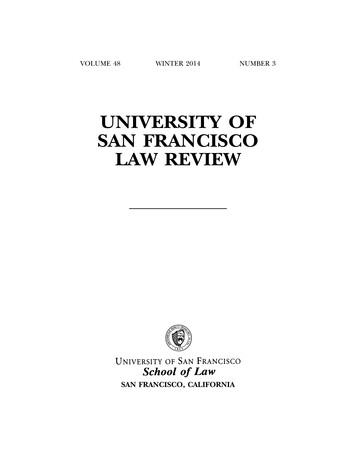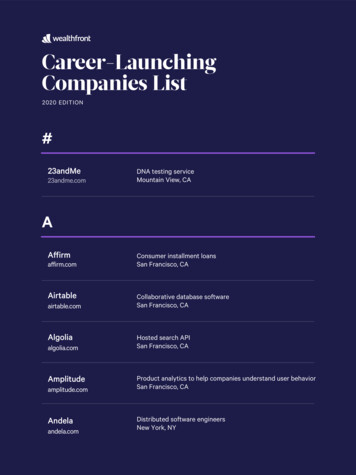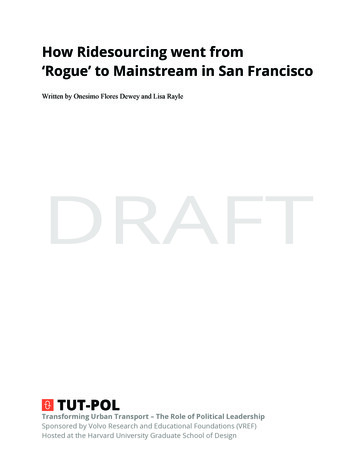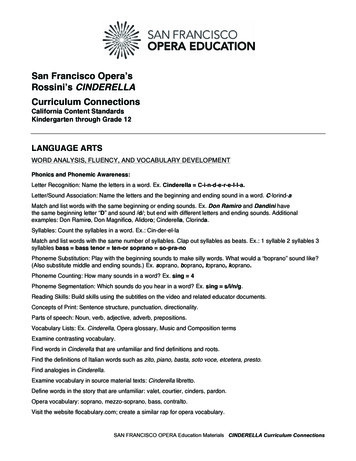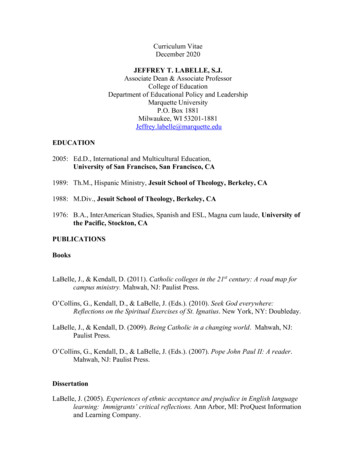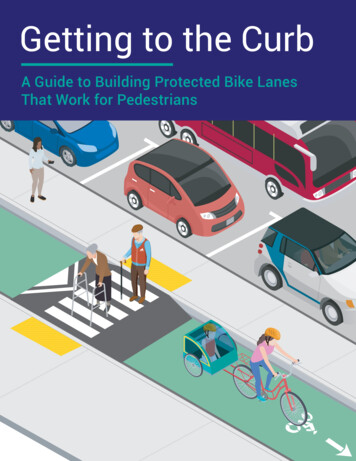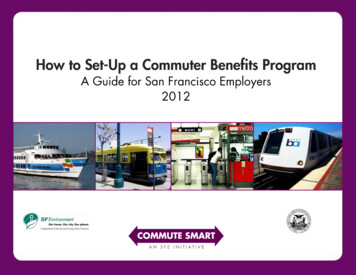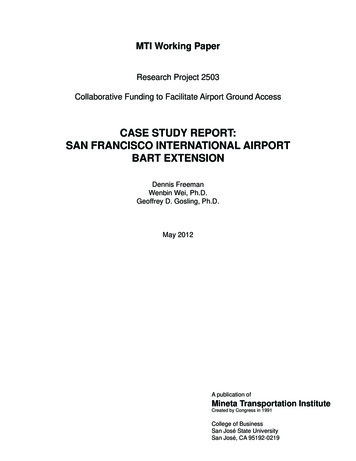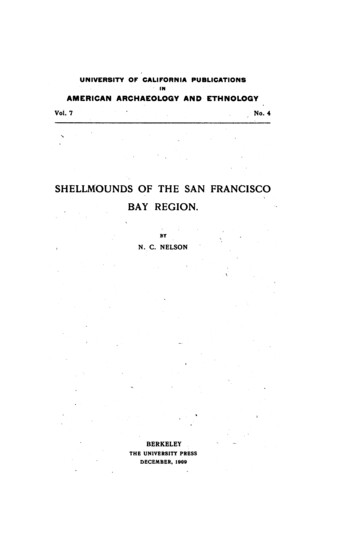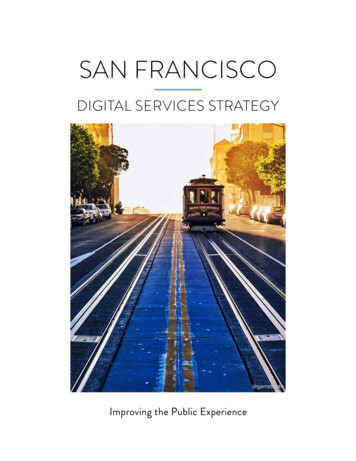
Transcription
SAN FRANCISCODIGITAL SERVICES STRATEGY@garrettrothImproving the Public Experience@garrettroth
Executive Sponsor:Naomi Kelly, City AdministratorWorking Group:Committee on Information Technology Mayor’s Office of Civic InnovationMayor’s Budget Office DataSF Department of Technology 311
Contents04Executive Summary08Putting Our Principles Into Practice10Our Call To Action14Building A Path Forward15Embrace Modern Practices17Deliver Services Digitally19Share Resources To Build Modern Digital Services21Develop A Central Strategy With Strong Leadership & Governance23Leverage Existing Key Projects As The Foundations28San Francisco’s Digital Services Roadmap29Recommendation 1 - Strong, Experienced Central Leadership30Recommendation 2 - A Modern, Expert Product Development Team31Recommendation 3 - Standardized Product Quality33Recommendation 4 - A Consistent City Brand & Experience35Recommendation 5 - New Strategy & Governance Body36Implementation Plan39Making Progress41Appendix A: Methodology42Appendix B: Digital Service Dictionary46Appendix C: Statistics49Appendix D: Interview & Workshop Materials
SAN FRANCISCODIGITAL SERVICESSTRATEGYImproving the Public Experience
@oscarwastaken@oscarwastaken
Executive SummaryMore than ever before, residents now expect services to be available online. Thedevelopment of new digital services is an opportunity to rethink how we deliverservices to ensure every resident and visitor has the access they need.San Francisco’s Digital Services Strategy promotes the development of new digitalservices to help improve the customer experience. Through comprehensive serviceredesign, the City seeks to streamline the customer service experience and make allservices accessible and easy to use for everyone.Core ValuesThe following values support our commitment to redesign the customer serviceexperience:Put Residents First: Resident needs should define the design of City services.Digital By Default: Services should be delivered digitally whenever possible.Integrated Service: Digital services should be managed by the core business, and notsiloed in IT.Build Expertise: The City should establish a team with modern skills and support anagile development culture.Collaborative Process: Development of City service standards should be collaborativeand contribute to a shared strategy.04
San Francisco’s Digital Services RoadmapFive recommendations support the implementation of the City’s strategic plan:1 Strong, Experienced Central LeadershipRecommendation: The City should identify and empower a trusted leader to guideservice redesign efforts. A dedicated, experienced thought leader will be a changeagent who drives a culture shift towards user-centered thinking and brings amodern approach to the development of digital products.The senior leader shouldhave a service design vision and deep experience as both a manager and atechnologist building consumer-oriented web products at scale.2 A Modern Expert Product Development TeamRecommendation: The City should pursue a shared services model to support serviceredesign efforts across the City. The Digital Services Team will be responsible forredesigning services, building new products, and working alongside thedepartments.The Team will be composed of the Digital Services Officer, designers, developers,product managers, analysts, and content strategists. The Team will also help createcitywide standards and guidelines and will continue to refine the Digital ServicesStrategy.3 Standardized Product Quality OversightRecommendation: The City should adopt modern, user-centered design methods forthe development of all services. From production to the ongoing maintenance, theCity should implement standard approaches to the design and delivery of services,specifically in the following areas:User TestingData ServicesAccessibility, Content, & LanguageProcurement & Vendor Management4 A Consistent City Brand & ExperienceRecommendation: The City should develop a common template and designguidelines to support a unified brand. The City should also continue to build crossdepartmental “one-stop” sites that help residents and visitors find the content andservices they need.5 New Strategy & Governance BodyRecommendation: A central governing body is needed to manage the ongoingstrategy and to approve standards. A working group of digital service experts shouldbe formed to promote collaboration and develop common standards.05
The Next StepsRealizing our vision to create moreintuitive and accessible services willrequire systematic redesign and aculture change in our day-to-daypractices. Following therecommendations above, the DigitalServices Team should makesignificant progress in improving howthe City delivers services in the nextyear.
@philpham07@philpham
Putting Our Principles Into PracticeDedicated To ServiceImagine a city where a teenager in the Bayview could log on and search for asummer internship from his cell phone, allowing him to gain valuable job trainingfor a future career. Or a family in the Mission could apply for affordable housingfrom a computer at their local library. Or even an aspiring café owner could apply forand track every permit for her business online on a City website.Digital services can make each of these scenarios a reality. Rebuilding a service toinclude a digital option means City services are more open and accessible. Serviceredesign means meeting the needs of every resident and visitor by continuallyimproving the service experience. Ultimately, better City services means building amore trusting relationship between the City and residents.San Francisco’s Digital Services Strategy is a commitment to promote thedevelopment of new digital services that improve the customer experience andmakes services more accessible. This strategic document promotes best practices forthe development of digital services and makes key recommendations to modernizethe City’s service culture. The Strategy also includes specific deliverables thatshould be achieved over the next year.In order to make all services accessible and easy to use, the Digital Services Strategyaims to initiate a culture shift towards user-designed services. Throughcomprehensive service redesign, the City seeks to streamline the customer serviceexperience.08
@ournextstop09
Our Call to ActionNow is the time!To reshape our service delivery practices, we need to better understand where weare right now and what residents and visitors need. Our journey began by realizingdigital services are no longer a luxury but a required part of modern service delivery.Residents Have New ExpectationsMore than ever before, residents expect services to be available online. SanFrancisco’s location in the heart of Silicon Valley only adds to the expectation forelegant digital services.In this new reality, the City’s website has become the front door to the City andCounty of San Francisco. In the last year alone, San Francisco’s sfgov.org websitehas had over 20 million unique page views. City websites are now the first place tolook for information and services.The increasing demand for digital services means now is the time to improve ourservice delivery strategies to meet the needs of residents.A Proven Path Already ExistsSan Francisco has the benefit of learning from others to accomplish our goals. In theprivate sector, countless examples are available on how to build modern digitalproducts. As we are all accustomed to, going online is the easiest and mostconvenient way to order a pair of shoes or buy a plane ticket.Governments across the world are also starting to follow these practices. Momentumis building in the government technology sector to transform business-as-usual intoservice delivery practices that are more efficient and accessible. Some of the mostprominent examples include:United Kingdom Government Digital Service (GDS) is a systemwide effort toconsolidate all government digital services under a single identity. All governmentwebsites and digital products are standardized to be as accessible as possible.Federal Government United States Digital Services (USDS) and 18F arerecent efforts that started following the near collapse of the Affordable Care Act’shealth care website. After fixing healthcare.gov, a new group of technology expertsare helping improve digital services throughout the Federal agencies.These leading examples are reshaping the way governments serve the public.10
Deeper Look: The United Kingdom’s TransformationIn 2011, the United Kingdom created the new office of the Government DigitalService (GDS) to implement a “Digital by Default” service strategy. Behind thesimple premise that digital services are more accessible and more efficient to deliver,the United Kingdom underwent a systemwide transformation to standardize andunify their web products.Since work has begun, GDS has created a new central portal in GOV.UK. A centralteam helped migrate agency websites and redesign digital services to better meetuser needs. A recent GDS blog post best describes the monumental effort andachievements made over the last two years: 300 websites to 1 in 15 months.GDS follows a strict model that standardizes all websites and services under a singletemplate. For consumers, the GDS model has the advantage of being the same nomatter what service they need. To learn more about GDS and their work, please visittheir blog at Inside GOV.UK11
Opportunity In San FranciscoCompounding our call to action is the current state of our service delivery practices.Currently, the City organizes services by department and by major service areas.However, for residents and visitors to San Francisco, this division of labor isconfusing and often irrelevant.For digital products, this is especially problematic. A City’s website is the first placeresidents and visitors will go to find information. Yet, San Francisco CityDepartments currently have over 50 domain names, more than 27 website designs,and many unreadable URLs. Further, by organizing services by departments, theCity may push customers to multiple websites just to find a single service. As aunified entity, City websites do not provide the service experience residents need.12
an@misslexy76@misslexy76
Building a Path ForwardTo improve our services to be more accessible and intuitive for everyone, we willhave change how the government thinks about service delivery. The following valuesare guiding our efforts to build a City that offers modern services.Put Residents First: Resident needs should define the design of City services.Digital By Default: Services should be delivered digitally whenever possible.Integrated Service: Digital services should be managed by the core business, and notsiloed in IT.Build Expertise: The City should establish a team with modern skills and support anagile development culture.Collaborative Process: Development of City service standards should be collaborativeand contribute to a shared strategy.14
Embrace Modern PracticesThe City and County of San Francisco is responsible for delivering thousands ofdifferent services. As a consequence, City services come in all shapes and sizes witha multitude of service delivery strategies.Although some departments have the resources to build modern digital services,many others are unable to follow best practices. The City needs to build a supportivestructure that ensures all digital products maintain a high standard of excellence.Two values guide our effort to improve the design of our services:Put Residents First: Resident needs should define the design of City services.Integrated Service: Digital services should be managed by the core business, and notsiloed in IT.The Digital ToolkitPutting these values into practice means creating a common standard for servicedelivery. The City should incorporate the following elements into the design andsupport of all services:User Research is fundamental to understanding each customer's story and theirneeds. To build accessible and intuitive services, this information is essential.Data Analysis is the foundation of an iterative design process.To achieve worldclass service delivery, data must drive learning and adaptation.Skilled Staff are required to build an ongoing process of improvement. IT staff mustwork hand-in-hand with the business to meet customer needs.Modern Tools are needed to support the production and maintenance of digitalproducts, with the flexibility to test and adapt as needed.Integrating these simple elements into the development of a digital service can haveprofound effects on a service’s non-digital elements. Both brick-and-mortar andphone services are often impacted by providing a digital option. What’s more,providing a digital option is often times more cost-efficient, saving both the customerand government money.15
Deeper Look: Fixing Healthcare.govIn 2010, President Obama signed the Affordable Care Act. Central to theimplementation of the legislation was the creation of Healthcare.gov to provideinsurance to millions of Americans.Unfortunately, when the website was launched in 2013, technological problemsmarred the release. The government’s methods to build and design the website wereout-dated and inappropriate for a modern technology project, putting the entireprogram at risk.Faced with a technological threat to his signature policy initiative, President Obamashifted strategies. Recruiting a small number of technologists from some of thecountry’s most prominent companies, a team of developers worked to fixHealthcare.gov. Their effort led to the website’s modern deployment that is bothuser-friendly and able to meet the needs of all consumers.The success of a small team of developers using modern practices started atransformation in the Federal government. Their success led to the creation of theUnited States Digital Services (USDS) to help other agencies build modern digitalproducts.The efficiencies and cost-savings proven from the healthcare.gov example is anexample of what is possible when modern practices are used in government.*Old MethodsAgile DevelopmentSavingsCost to Build (millions)Cost to Maintain (millions) 250 70 4 1 246 69“The Secret Startup That Saved the Worst Website in America.” The Atlantic. Atlantic Media Company.2015. st-website-in-america/397784/16
Deliver Services DigitallyCity services should always provide a digital option and all services must bedesigned by incorporating the needs of residents and visitors first. Our guiding valuefor the future of City services is:Digital by Default: Services should be delivered digitally whenever possible.The future design and development of services should consider the followingelements.Redesign Service from the Ground UpBuilding digital options for City services is an opportunity to not only make servicesaccessible online, but to rethink how we provide a service experience. However, theCity should be careful and not just create a digital version of a bad process.Rebuilding a service to include a digital option allows us to question and redesignthe steps and requirements of each service in an ultimate effort to streamline thecustomer experience.Migrate Paper to DigitalThe opportunity to build digital services means more than building new websites.The creation of a truly supportive service strategy also means replacing inefficientservices, like anything that relies on paper.Building a digital option is a key part of increasing accessibility. Requiring forms tobe filled out in person or to send them through the mail is cumbersome and too timeintensive for many residents. Wherever legal or other obligations do not requirepaper, making a service available online means providing an alternative servicechannel that is easier to access.Create Digital Front DoorsThe City should seek to build one-stop sites that bring related services together inone location. Our homepage on sfgov.org should contribute to this goal and bedesigned as the first stop for all residents and visitors. When coming to our websites,consumers should be able to find the information or the service they want quicklyand easily.17
Deeper Look: A Digital Front DoorThere are many great examples of City websites changing their front page to helptheir residents get services quickly and easily. The City of St. Louis recently engagedin a project to redesign their websites to better meet user needs. Key to theirredesign effort: bringing services to the front page.St. Louis is also pioneering a way to connect specific audiences to services. Throughtheir front page, visitors can access the services they want immediately.18
Share ResourcesThe City needs skilled staff to build and maintain digital products. However, the keypositions needed to do the work either do not exist or are spread too thinlythroughout the City.The Department of Technology (DT) has staff already dedicated to helpingdepartments build digital products. In addition to maintaining many City websites,DT helps develop web services and digital applications. Unfortunately, thedepartment is insufficiently resourced to meet the increasing demand, leading to anincreased use of outside contractors.As a guiding value, the City needs increased support for the development of digitalservices.Build Expertise: The City should establish a team with modern skills and support anagile development culture.In practice, a team of digital experts will help create a service culture that prioritizesuser needs and and builds capacity to manage digital services within the City.The Components of a Shared ServiceCreating a team that helps build accessible and intuitive digital services will requirerethinking how the City is organized and how it is staffed. Meeting the needs ofevery resident and visitor means making sure small departments are able to deliverthe same standard of digital services as large departments. To accomplish this goal,the City must share resources.A central team must be able to:Build web services and digital applications. These products should use modernpractices to meet the needs of consumers.Maintain digital products so that they continue to operate as expected and are in aconstant state of improvement.Consult with other staff and departments to share best practices and advise on thedevelopment of new products to align with the City’s new Digital Services Strategy.A shared service staffing model is the most efficient way to build new digitalproducts.19
Deeper Look: Improving Tech HiringThe City and County of San Francisco is the largest employer in the city with about32,000 employees. City technologists tackle everything from making sure police andfirefighters can communicate when the air is blazing with smoke and alarms, toensuring emergency room doctors get critical patient records.Against the backdrop of full employment and fierce competition with some of theworld’s top technology companies, the City is positioning itself as an employer ofchoice for top tech talent. The Department of Human Resources (DHR) haspartnered with the Department of Technology (DT) and other City departments todevelop the TechHire program. Research conducted as part of this program showedthat across all demographics, today’s technologists are really looking for meaningfulwork. And more than anything, the City can offer purpose.The TechHire program pairs a marketing campaign with changes to the City’s hiringpractices that will improve its ability to hire and retain top tech talent. By deliveringa more efficient hiring process, moving to a competency-based hiring model, andproviding additional hiring options, joining the City will be quicker and moreefficient than ever.One new model DHR has proposed to use to hire permanent civil service positions iscalled FlexSelect. FlexSelect is based on the recent nurse hiring model that tookhiring time from 193 to 40 days. By using continuous eligible lists in IT engineerclassifications and by specialty area, hiring managers are enabled to quickly andefficiently identify highly qualified candidates.Over the next year, the City’s Department of Human Resources will provide updateson the progress of TechHire through monthly video presentations, human resourcesprofessionals meetings, and forums through their site at:http://dhrportal.org/wp-content/uploads/flash files/Tech Hiring/20
Strong Leadership and GovernanceUltimately, the inconsistencies between City digital services are largely due to thelack of a unified citywide strategy. Departments build and design their services tomeet the needs of their customers, often without reference to other departments orother similar services. But as demand for more digital services grows, the City hasan opportunity to create a more unified service experience and to leverage and scaleits investments.A guiding value is to build a consistent service experience by improving crossdepartmental collaboration.Collaborative Process: Development of City service standards should be collaborativeand contribute to a shared strategy.The unification of service delivery practices under a larger service strategy willcontribute to the development of a streamlined customer experience.Benefits of a Central Digital StrategyAmong the most helpful elements of a citywide service strategy is to help organizeand coordinate San Francisco’s digital presence. Other benefits include:Prioritize the development of digital products. Many City services need new digitalinterfaces to be built from the ground up. A strategy can help prioritize thedevelopment or redesign of services with the most impact.Share Best Practices. City staff must constantly learn the most effective methodsto build and maintain digital products. Standards can help support best practices.Develop a City Brand. Departments will have to agree to follow common serviceelements to create a consistent service experience. A citywide strategy helpsarticulate the governance process to agree on citywide standards.The development of a central strategy is a fundamental component to improving theCity’s service experience.In addition to a citywide digital strategy, departments should also engage in theirown strategy development to better meet the needs of their individual users.Department-specific strategies should be encouraged to rethink their service designsand re-analyze their customer’s needs.21
Deeper Look: HSA Digital Strategy ReportThe Human Services Agency (HSA) is currently implementing a digital strategy thatpromises to transform its relationship with residents across San Francisco.The San Francisco Human Services Agency is a lifeline for 23% of San Franciscans,serving over 200,000 unique persons seeking essential social services. HSA helpsresidents find pathways to self-sufficiency through welfare-to-work services, food(CalFresh), medical care (Medi-Cal), and child-care assistance programs, amongothers. HSA services also help veterans, the homeless, and those experiencing abuseor who are homebound.HSA’s Digital Strategy is an effort to improve service delivery, strengthening itsrelationship with the community. By rethinking how to design services, HSA isfinding new ways to better assist San Francisco residents.The Agency has been approaching the rebuild of its website in three phases.Phase 1 was to research the current landscape of how clients, community partnersand employees currently experience the website. Google Analytics and GoogleWebmaster provided vital data of how people where using SFHSA.org and on whatsort of devices.Phase 2 is about creating and implementing an effective content strategy: decidingwhat content stays or goes, making all content accessible from the users’perspectives, and then creating an internal Agency process to sustain relevant andaccessible content.Phase 3 is about transactions or service delivery by enabling HSA and website usersto exchange information and documentation.An “Agile” approach will be used through a process of quick, repetitive, cycles offinding people’s pain points with the website, making changes, and getting feedback.To read more about HSA’s digital strategy, see here:http://exygy-design.github.io/hsa-docs/22
Leverage Existing Key ProjectsSan Francisco’s path forward is clear. To meet the needs of residents and visitors,more digital products need to developed. By rethinking how to put residents andvisitors first, the City can provide world-class services.Several projects are already paving the way forward. Innovative digital services arebeing developed across the City, exhibiting the very values wanted in our citywidedigital strategy. Among the most prominent are:SF311: San Francisco Customer Service CenterThe SF311 center provides an easy-to-remember telephone number that connectsresidents, businesses, and visitors to Customer Service Representatives ready tohelp with general government information and services. The easiest way to obtaininformation, report problems, or submit service requests to the City is through one ofthe many 311 contact channels.SF311 maintains a comprehensive knowledge base of City services and workscooperatively with all departments to understand the department service offerings.SF311 has focused continually on simplifying processes, digitizing them when able,and allowing the public to reach the City through an expanding range of contactoptions.Over the years, SF311 increased the options to help customers. Now residents andvisitors have the option to contact SF311 through multiple 207020With multiple options, analysis shows that the public is increasingly using digitalchannels to request City services. For example in 2015, 311 received a total 325,436requests from residents and visitors, with 50% coming from Web and mobile options.SF311 continues to focus on the customer experience with recently launched websitethat allows for user accounts, an improved search, and simplified service requestmanagement.23
San Francisco Business PortalThe San Francisco Business Portal provides a user-focused approach to providinggovernment services to small business owners. Under the leadership of SanFrancisco Mayor Lee, the Business Portal team partnered with the Department ofTechnology (DT) and the Office of Economic and Workforce Development to conductextensive user experience research with local business owners. The Business Portalis now home to over 400 permits with a responsive design that allows easy accessacross devices.Analytics and customer feedback now inform decisions related to improving thePortal and its future digital offerings. The Business Portal now receivesapproximately 4,000 users per month, a measure that is 13 times more than theCity’s previous permitting information site. Approximately 61% of users are over theage of 35, and mobile users make up 10% of the total.The San Francisco Business Portal continues to improve by taking an iterativeapproach to new features. The next phases of the Portal will continue to simplify theexperience of starting and managing a business.The Business Portal is a model on how to deliver government services digitally andhow every city agency should interact with its citizens. In the years since initialdevelopment, the Business Portal has inspired the creation of several other one-stopdigital products, including a portal for affordable housing and the Jobs Portal.Assessor-Recorder Office Website RedesignLast year, the Assessor-Recorder’s Office launched a major redesign of its publicwebsite to better serve San Francisco’s taxpayers and residents. The site was createdto feature new customer service content, better navigation, improved searchfunctionality, and accessibility for desktop and mobile users. Recognizing the needfor its website to reach a much broader audience and make service delivery easier,the Assessor-Recorder transformed how her office virtually connects with the public.The office began with analyzing its customers’ needs, frequently asked questions andcommon requests for information. To serve all taxpayers who work and live in SanFrancisco, as well as business owners, it was vital that the website provided relevantinformation that was easier to find and clearer explanations of technical, legallanguage. While a large part of the Assessor’s work still relies on paper processes, itswebsite now helps customers get the information they need more efficiently.The Assessor-Recorder’s Office developed its website through a collaborative, datadriven process involving stakeholders and customers. To maintain the site, theAssessor’s staff is dedicated to an ongoing process to update and improve thecontent. Staff analyzes customer questions and legal changes to update its websitecontent and provide information in a more intuitive manner. By re-evaluating whotheir users are and what information they want, the Assessor’s Office was able todevelop an excellent example of what City websites can provide.24
Deeper Look: Innovative New PracticesIn December 2015, the Department of Technology (DT) began piloting a newapproach to client service delivery for a new digital service for the Office of ShortTerm Rentals (OSTR), which regulates hosts on AirBnB and similar platforms.OSTR urgently needed a web presence and digital services with a rapidlyapproaching legislative deadline that required citizens to report short-term rentals.Using a team of three people, DT designed and launched a “digital by default”service in less than 20 business days that achieved 95% user adoption.The project approach became known in DT as “Skunkworks”. A skunkworks projectis a
San Francisco’s Digital Services Strategy is a commitment to promote the development of new digital services that improve the customer experience and makes services more accessible. This strategic document promotes best practices for the development of digital services and makes key
